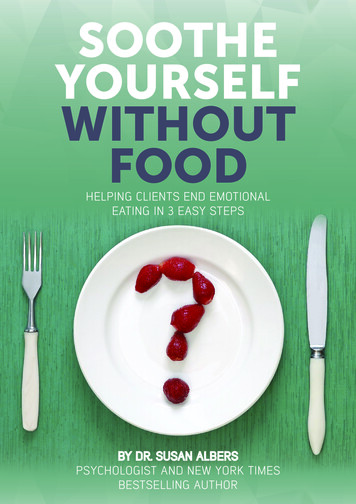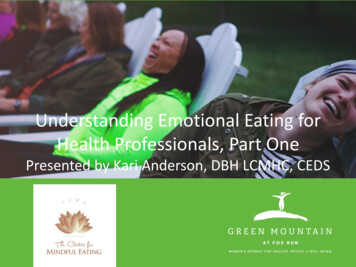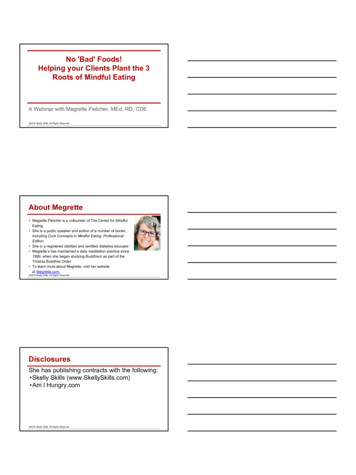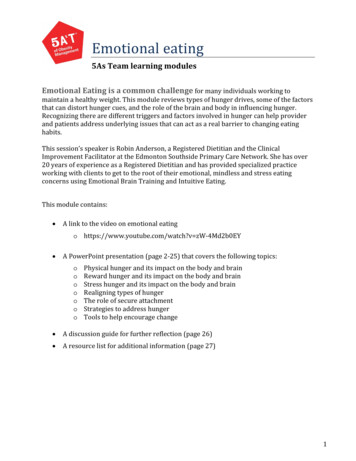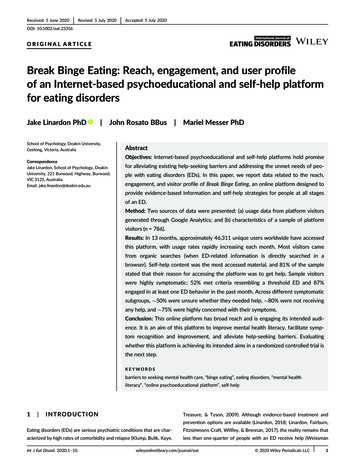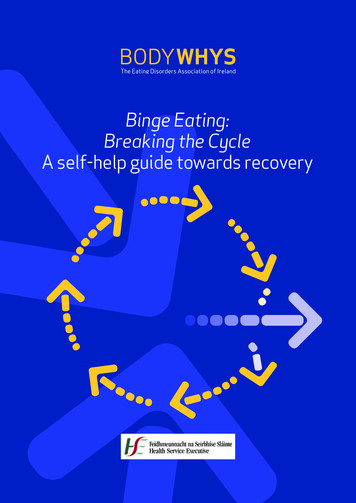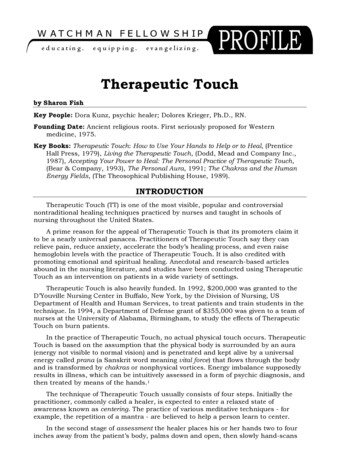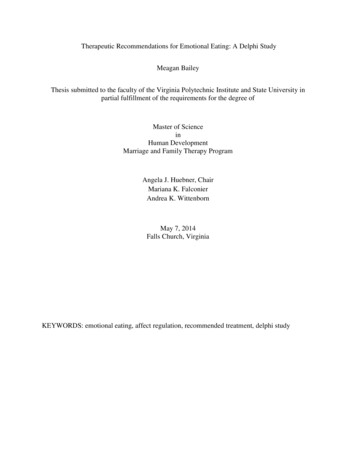
Transcription
Therapeutic Recommendations for Emotional Eating: A Delphi StudyMeagan BaileyThesis submitted to the faculty of the Virginia Polytechnic Institute and State University inpartial fulfillment of the requirements for the degree ofMaster of ScienceinHuman DevelopmentMarriage and Family Therapy ProgramAngela J. Huebner, ChairMariana K. FalconierAndrea K. WittenbornMay 7, 2014Falls Church, VirginiaKEYWORDS: emotional eating, affect regulation, recommended treatment, delphi study
THERAPUTIC RECOMMENDATIONS FOR EMOTIONAL EATINGTherapeutic Recommendations for Emotional Eating: A Delphi StudyMeagan BaileyABSTRACTEmotional eating is a common behavioral phenomenon that involves eating in response toemotional impulses rather than physical hunger and is believed to be a form of affect regulation(Ball & Lee, 2002). While emotional eating occurs within the symptomology of eating disordersit also occurs independently (Benett, Greene, & Schwartz-Barcott, 2012). Further, a pattern ofemotional eating can lead to weight gain and the development of eating disorders (Grant &Boersma, 2005). Currently, research is limited in terms of smart practice treatmentrecommendations for emotional eating. In order to address this gap in research, the Delphimethod was utilized in order to gain consensus from a panel of nine experts regarding treatmentrecommendation specific to emotional eating. These panelists identified 47 treatmentinterventions that will be discussed.
THERAPUTIC RECOMMENDATIONS FOR EMOTIONAL EATINGiiiAcknowledgementsSpecial thanks to Dr. Angela Huebner for keeping me on track and from going down thewrong research path. You enthusiasm, feedback, calmness, humor, faith, candidness , and toomany other superlatives to mention were very much appreciated and kept me going throughoutthis long process.Thanks to the members of my committee, Dr. Marina Falconier and Dr. AndreaWittenborne. Thank you for your input and helping me go in the direction that I needed to. ToDr. Witterborne, thank you for help me start out on this journey and to Dr. Falconier, thank youfor helping me make my paper stronger.Special love to my classmates, especially Martha Fisher who helped me feel like this waspossible and for providing guidance and support throughout. To May Kanti for helping me findperspective and taking the time to give me feedback when it was most needed. Yourencouragement and humor are been invaluable. Much love to my best friend Robin Corbo forher compassion, strength, and immense help from 2,798 miles away.Thanks to my family for your endless support, to my mother who has helped me in moreways than can be counted and has literally sat beside me many times during this process. To myfather for endless reassurance and empathy. To my husband, Justin Herzog, for his tireless love,patience, encouragement, and sacrifice-I promise we will get our weekends back soon! And tomy cats who kept me company and provided stress relief and humor whether they intended to ornot.
THERAPUTIC RECOMMENDATIONS FOR EMOTIONAL EATINGivTable of ContentsAbstractAcknowledgementsTable of ContentsiiiiiivChapter I: IntroductionThe Problem and its SettingEmotional EatingEmotional Eating & EmotionsEmotional Eating as Affect RegulationThe Difference between Emotional Eating & Binge Eating DisordersSignificanceRationale for MethodologyTheoretical FrameworkPurpose of the Study11245689911Chapter II: Literature ReviewEmotional Eating BehaviorInfluences on Emotional EatingAffect Regulation OverviewEmotional Eating as Maladaptive Affect RegulationTreatmentResearch Question13131519222326Chapter III: MethodsDesign of the StudyDelphi Panel SelectionDelphi ProceduresData Analysis2727272930Chapter IV: ResultsExpert Panel DemographicsClient DemographicsAnalyses: Questionnaire IAnalyses: Questionnaire II3333363849Chapter V: DiscussionCorrespondence of Results with Relevant LiteratureRecommendations and Implications for TreatmentImplications for ResearchLimitations of this StudyConclusion636365696970REFERENCES72
THERAPUTIC RECOMMENDATIONS FOR EMOTIONAL EATINGAPPENDICESAppendix A Email Letter IAppendix B Informed ConsentAppendix C Questionnaire IAppendix D Email Letter IIAppendix E Questionnaire IIAppendix F IRB Approval LetterAppendix G IRB Approval Letter: Amendmentv898991939596101102
THERAPUTIC RECOMMENDATIONS FOR EMOTIONAL EATING1Chapter I: IntroductionThe Problem and its SettingFor well over half a century, psychologists have studied and documented the relationshipbetween emotions and the consumption of food. They have found that both food choice andquantity can be affected by emotions, this phenomenon has been dubbed “emotional eating”(Ganley, 1989). It is estimated that one-fourth to one-third of the population engages inemotional eating (Laitinen, Ek, & Sovio, 2002). Why individuals use food in order to cope isoften complex, however, researchers have identified that this response frequently occurs inreaction to negative emotions. Indeed, numerous studies have confirmed that emotional eating isan attempt to regulate emotions or affect as food is utilized in order to numb and distract fromthese negative emotions (Ball & Lee, 2002; Denisoff & Endler, 2000; Freeman & Gil, 2004;Koff & Sangani, 1997; Oliver; Wardle, & Gibson, 2000; Van Strien & Ouwens, 2003;). Whileemotional eating is highly prevalent, there is limited information regarding therapeuticinterventions specifically for emotional eating (Andrade, 2005; Bohon, Stice, & Spoor, 2009;Brown, brow, & Wrobleski, 2009; Ganley, 1988; Gross, Richards, & John, 2006; Heatherton &Baumeister, 1991; Macht, 2008; Martin, 2001; Spoor, Bekker, Van Strien, & van Heck, 2007;Van Strien, Frijters, Berger, & Defares, 1986). In addition, while emotional eating has beenidentified and treated as part of eating disorder symptomatology, it differs in nature and severityfrom eating disorders which are defined as chronic, causing substantial distress, physical andmental impairment, and psychiatric comorbidity (American Psychological Association, 2013;Hudson, Hiripi, Pope, & Kessler, 2007). Nevertheless, emotional eating can still causefrustration and distress and is linked with increased self-criticism, shame, unsuccessful dietingattempts, weight gain, as well as a greater risk of developing an eating disorder such as binge
THERAPUTIC RECOMMENDATIONS FOR EMOTIONAL EATING2eating disorder and bulimia nervosa (Grant & Boersma, 2005; Grilo, Shiffman, &Wing, 1989;Sarlio-Lahteenkorva, 1999 ; Stice et al., 2002; Van Strien, et al., 2005). Therefore, treatmentpractices for emotional eating need to be better understood and explored outside of thedimensions of eating disorders.Emotional eating. It is common knowledge that emotions can induce changes in eatingbehavior in humans. How emotions impact eating can depend on a variety of both personal andenvironmental factors (Ganley, 1989; Greeno & Wing, 1994; Robbins & Fray, 1980). Forexample, the natural biological response to negative emotions and stress is typically the cessationof eating. However, for some, these emotions illicit the opposite reaction resulting in anincreased food consumption (Macht, 1999). This phenomenon was first thoroughly investigatedin 1957 by Kaplan and Kaplan who found a significant relationship between food overconsumption in obese individuals with anxiety. They discovered that eating was a way forindividuals to soothe and thus cope with negative feelings and emotions related to their anxiety.They labeled this new phenomenon “emotional eating.” Emotional eating has since been definedas the overconsumption of food in response to emotional, rather than physiological, cues markedby an tendency to consume sugary, high fat, and energy dense foods (Nygen-Unger, & SpruijtMetz, 2007; Van Strien & Oosterveld, 2008). Indeed, the conclusion of over 50 studies onweight gain and obesity shows that emotional eating is consistently caused by experiences ofemotional distress, including depression, anxiety, anger, and loneliness (Ganley, 1989). Whileemotional eating is associated within the symptomatology of eating disorders, most commonlybinge eating disorder (BED) and bulimia nervosa (BN), it also occurs in individuals that do notmeet the criteria for an eating disorder in accordance with the Diagnostic and Statistics ManualFifth Edition (DSM-V) (American Psychiatric Association, 2013; Benett, Greene, & Schwartz-
THERAPUTIC RECOMMENDATIONS FOR EMOTIONAL EATING3Barcott ,2012; Canetti, Bachar, Berry, 2002; Ganley, 1989; Laitinen et al., 2002 Reel, 2013;Wilson, Nonas, & Rosenblum, 1993, Macht, 2008; Waller & Osman, 1998). Further, Latinen etal. reported in a 2002 study that in a group of individuals who were not diagnosed with an eatingdisorder showed a 30 to 48 percent increase in food consumption when experiencing emotionaldistress. Additionally, a 2012 study on college students that specifically focused on non-eatingdisordered emotional eating found eating occurring as a pattern of coping in response to stress(Benett, Greene, & Schwartz-Barcott). While emotional eating has also been found to occurpredominantly in women that are overweight, it also occurs in women and men in the normativeweight range (Agras & Telch, 1998; Polivy, Herman, & McFarlane, 1994; Tabor, 2006; Ganely,1989; Macht, 1999; Macht & Simons, 2000; Ouwens et al., 2003). Studies have also found ahigher prevalence of emotional eating in both men and women with depressive symptoms(Konttinen, Mannisto, Sarlio-Lahteenkorava, Silventoinen, & Haukkala 2010; Pidgeon, Lacota,& Champion, 2012). Emotional eating also occurs among all socioeconomic levels(Ganley,1989). This research has led to speculation that emotional eating is, in part, influencedby individual characteristics and the causality of this behavior and its relationship to socialenvironment is complex in nature (Ganley, 1989; Greeno & Wing, 1994; Laitinen et al., 2002;Zysberg & Rubanov, 2010).Emotional eating is considered a biologically abnormal response wherein the increasedconsumption of food is contrary to expected physiological responses during times of distress(Schachter, Goldman, & Gordon, 1968). Typically, distress triggers the sympathetic nervoussystem to send a message to redirect blood from the digestive system to the external extremities,in preparation for the fight or flight response thus decreasing appetite (Parker, Parker, &Brotchie, 2006). Emotional eating runs counter to this process and can distort the natural
THERAPUTIC RECOMMENDATIONS FOR EMOTIONAL EATING4physiological reaction over a period of time by altering the brain’s reward system. For example,dopamine and other neurotransmitters associated with increased positive feelings are found todecrease in obese individual who eat in response to emotional stimuli (Davis, Strachan, &Berkson, 2004). In addition, when presented with a milkshake during a time of negative emotion,self-reported emotional eaters were found to have increased activity in the parahippocampalgyrus and anterior cingulated cortex areas of the brain which are linked with the brain’s rewardsystem. In contrast, non-emotional eaters showed a decrease in neural activity in their brain’sreward system during both negative and neutral emotional periods (Bohon et al., 2009)Emotional eating and emotions. It is widely believed that emotional eating is sustainedand utilized as a way to cope with negative emotions by way of soothing, numbing, anddistracting (Ball & Lee, 2002; Denisoff & Endler, 2000; Freeman & Gil, 2004; Koff & Sangani,1997; Oliver, Wardle, & Gibson, 2000; Van Strien & Ouwens, 2003). These negative emotionstypically include anger, boredom, anxiety, and loneliness (Arnow, Kenardy, & Agras, 1995;Ganley, 1989; Macht, 1999). Themes of guilt, shame, self-judgment, and perceptions of personalcharacter flaws have also been reported in those who emotionally eat. Further, emotional eatingis associated with negative self-judgment resulting in decreased self-esteem which then increasesnegative emotions. A strengthened pattern of coping by eating may then result (Hernandez-Hons&Woolley, 2012; Reel, 2013). Though negative emotions are often cited as rationale foremotional eating, there is some evidence that emotional eating is attributed to positive emotionsand experiences such as joy and celebration (Canetti, Bachar, Berry, 2002; Ganley, 1989; Macht,1999).According to a 2012 study by Hernandez-Hons and Woolley, emotional eating may alsobe used to compensate for an emotional void. For example, one participant described emotional
THERAPUTIC RECOMMENDATIONS FOR EMOTIONAL EATING5eating with the following, ‘‘It’s like so good and I’m so happy to be sitting right here eating this‘Chunky Monkey’ and nothing else matters, you know? When eating makes me feel betteremotionally, that’s what I describe as emotional eating’’ (p. 593). Study participants alsodescribed food as a distraction, a way to bring back memories, as well as a defense.Emotions that follow emotional eating often include feelings of guilt and shame (Bennett,Greene, & Schwartz-Barcott, 2012; Bruch 1973; Dube, LeBel, Lu, 2005; Hernandez-Hons &Woolley, 2012; Snoek, Engels, Janssens, & van Strien, 2007). Further, feelings of guilt occurringduring emotional eating as opposed to after have been labeled as “consumption guilt" (Kivetz &Simonson, 2002). Guilt and shame have also been found to occur when eating in public,especially for overweight emotional eaters. For example, emotional eaters reported feelings ofbeing watched and judged by others regarding what they eat or the foods that they purchasedbringing up feelings of shame (Hernandez-Hons & Woolley, 2012).Additionally, a 2010 study (Zysberg & Rubanov) found a link between emotional eatingand lower emotional intelligence. The term emotional intelligence refers to the ability tofunctionally accommodate and adapt to internal and external condition by identifying andprocessing complex emotions. Lower levels of emotional intelligence are linked to a decreasedability to cope with stressors and emotions (Mayer, Caruso, & Salovey, 1999; Zysberg &Rubanov, 2010).Emotional eating as affect regulation. Affect regulation is based on the principle thatindividuals will act to preserve or alter the experience of perceived negative or positive states(Gross, 1998). Considering emotional eating, the negative emotions and experiences mentionedabove are regulated by eating. Indeed, studies have overwhelmingly found that emotional eatingis a form of affect regulation (Andrade, 2005; Bohon et al. 2009; Brown et al., 2009; Ganley,
THERAPUTIC RECOMMENDATIONS FOR EMOTIONAL EATING61989, 1988b; Gross et al., 2006; Heatherton & Baumeister, 1991; Macht, 2008; Martin 2001;Spoor et al., 2007; Van Strien et al., 1986). The term affect refers to the climate of feelingsconnected to mood and emotion (Larsen, 2000). For example, if a person is experiencing anegative emotion or mood, the feeling might be distress. The individual may then attempt to alterthe mood or emotion based on the feeling of distress. This is called affect regulation. In regard toemotional eating, studies have found that affect regulation is achieved by the consumption ofcalorie dense food in order to ameliorate negative emotions. For example, eating may provide adistraction, bringing relief from self-awareness and critical self-thoughts (Heatherton, Herman &Polivy, 1991). In addition, affect regulation often occurs during times of stress and can lead to alack of impulse control. Such behaviors do not occur solely with food but also other selfregulatory restraints such as smoking, shopping, gambling, drugs, and sex. In these instances,impulse control based on long term goals such as weight loss can be disregarded in favor of animmediate reward. Indeed, studies have found that when individuals are under emotionaldistress, such as anxiety or depression, priority is shifted to short-term gratification and escapefrom self-awareness. In a 1981 emotional eating study, Edelman found that seventy percent ofhis test subjects who self-identified as emotional eaters used food to alter their emotional states.Another emotional eating study conducted by Swanson and Dinello (1970), found that subjectsreported that, “they obtained some relief from anxiety and frustration by eating” (p. 123). Inaddition, the use of food to alter negative affect was found in nine other studies and identified asa key causality in emotional eating (Ganley, 1989).The difference between emotional eating and binge eating disorders. It is welldocumented that emotional eating plays a role in the binge eating behavior in both Binge EatingDisorder (BED) and Bulimia Nervosa (BN) (Ouwens, van Strien, van Leeuwe, & van der Staak,
THERAPUTIC RECOMMENDATIONS FOR EMOTIONAL EATING72009; Stice, Shah, & Nemeroff, 1998; Wolfe, Baker, Smith, & Kelly-Weeder, 2009). However,it is important to make a distinction between emotional eating as an atypical eating behavior andbinge eating disorders such as BN and BED (van Strien, 2002). For example, both BED and BNare characterized by a greater degree of severity of mental and physical impairment thanemotional eating (American Psychiatric Association, 2013; Ricciardelli & McCabe, 2004). BNand BED are both characterized by diminished social functioning, lower life quality, greaterseverity of psychiatric comorbidity, and overall poorer physical health (American PsychiatricAssociation, 2013; Hudson et al., 2007; Wilfley, Schwartz , Spurrell, & Fairburn, 2000;Yanovski, 2003). While emotional eating is associated with distress, frustration, and inability tomaintain weight loss, the level of impairment is not as chronic or pervasive (Grant & Boersma,2005; Sarlio-Lahteenkorva, 1999; Stice et al., 2002; Van Strien et al., 2005). Additionally, thosediagnosed with binge eating disorders have been found to exhibit a greater degree of loss ofcontrol over eating behavior (Gold, Frost-Pineda, & Jacobs, 2003; Ricciardelli & McCabe,2004). A 2004 study also found that those with binge eating disorders were less able to engagein foresight (Ricciardelli & McCabe). Further, those diagnosed with binge eating disorders showan overall greater preoccupation with food (Crow, Agras, Halmi, Mitchell & Kraemer, 2002;.Johnson, Spitzer, & Williams, 2001; Wilfley et al., 2000). For example, a majority of individualdiagnosed with BED show symptoms of food addiction (Gerhardt, et al., 2011). Food addictionis characterized by diminished control during food consumption and the inability to reduce theamount and frequency of consumption, regardless of negative consequences (Davis & Carter,2009; Gerhardt, Corbin, & Brownell, 2009; Gold et al., 2003). Additionally, food addiction hasbeen found to be similar to substance addiction and in some cases can be quite severe. Forinstance, a recent study (Gerhardt et al., 2011a) found that those with BED who scored higher on
THERAPUTIC RECOMMENDATIONS FOR EMOTIONAL EATING8a food addiction scale showed similar neural patterns of disinhibition to that of cocaine users. Inthe case of food addiction, eating may not occur as a reaction to negative emotions but ratherneurological impulses. Those who have food addiction tend to consume more food thanindividuals who eat emotionally (Gerhardt et al., 2011b). Ultimately, while there may notinitially appear to be great distinction between emotional eating and binge eating disorders, suchas BED and BN, it is clear that significant characteristics and impacts of each differ considerably(Heatherton, Striepe, & Wittenberg, 1998).SignificanceEmotional eating is a common phenomenon and while techniques and interventions, asdiscussed below, have been identified and proposed, little research could be found on how or ifthese recommendations are utilized or applied by therapists. For example, most studies onemotional eating focus on the causation rather than treatment application. Concurrently, there isa significant amount of popular literature generated on the topic of emotional eating. Forexample, a keyword search of “emotional eating” on the popular retail website Amazon.comyields thousands of results largely under the subject heading of “self-help” and “weight loss”.Yet, little academic research could be found regarding how emotional eating is best treated in aclinical setting. Additionally, there is a lack of information about how therapists work withclients as well as conceptualize and apply treatment to emotional eating not diagnosed as BED orBN. Therefore, it is important fill this gap in literature by identifying salient themes andrecommendations regarding treatment for emotional eating. By compiling this data via consensusfrom experts in the field, the hope is to create informed treatment recommendations and directionfor future research in order to both increase and enhance therapeutic and research knowledgewith the goal of better serving clients.
THERAPUTIC RECOMMENDATIONS FOR EMOTIONAL EATING9Rationale for MethodologyThis study was conducted using the Delphi research method. The Delphi method is avaluable research tool for researchers who are, exploring emerging topics and theories,generating recommendations for the development of future interventions, and closing the gapbetween practice and research. The Delphi method is especially salient as it utilizes expertopinion via structured communication in order to reach consensus. It additionally allowsresearchers to draw from a diverse field of both experience and knowledge. Further, the use ofcollective input based on expert opinion has been found to generate better understanding ofspecific or understudied topics (Stone Fish & Busby, 1996). Therefore, the Delphi method is auseful and practical application for generating greater insight regarding the understudied topic oftherapeutic invention for clients who emotionally eat. Through this method the goal will be tohighlight key and effective treatment interventions from those who understand it best in order tocreate better informed recommendations for treatment and future research.Theoretical Frameworks: Emotional Eating Theory, Affect Regulation Theory, and SmartPracticeEmotional eating theory was original proposed by Bruch (1973) and is related topsychodynamic thinking. Bruch’s emotional eating theory operates under two main assumptions.The first assumption is that negative emotions increase desire and cravings to consume foodwhich is then followed by eating. The second assumption is that by eating, the intensity ofnegative emotions is reduced. This is similar to the tenets of learning theory which states thatnegative emotions create a classically conditioned response of food craving that are thenfollowed by an operant response of food consumption which then lessens negative emotions,further reinforcing eating as a way to cope with negative emotions when they arise (Booth,
THERAPUTIC RECOMMENDATIONS FOR EMOTIONAL EATING101994). During the past 40 years numerous studies have found evidence supporting the validity ofthis theory (Agras & Telch 1998; Booth, 1994; Herman & Polivy, 2005; Macht, 2008;Slochower ,1976; Slochower & Kaplan, 1980).It is also important to note the relationship between emotional eating theory and affectregulation theory. Affect regulation theory states that emotional stimuli are processed reflexivelyand responded to via bodily-based survival mechanisms such a fight, flight, or flee (Schore,2001). This is also the premise of emotional eating theory, however in emotional eating theory,the self-protective response is specifically defined as food consumption (Bruch, 1973). Affectregulation theory also elaborates on the mechanisms for unconscious reactions by exploringthrough neuroscience the location of emotional stimuli in the brain (Schore, 2001). This theoryalso builds upon attachment theory surmising that early childhood relationships later shape one’sreaction to emotional stimuli (Schore, 2008).Smart practice research and the delphi method. Smart practice research is based onthe theoretical assumption that rather than placing abstract suppositions on what might work toachieve a desired resulted we should seek to better understand and develop what is currentlybeing utilized and proven to be effective. Smart practice is also known as best practice (Veselý,2011). However, this researcher employed the term “smart practice” in agreement with Barrdach(2000), who felt the title “best practice,” could be construed as misleading as it is not feasible tofully utilize exemplars from all possible options. The term smart practice acknowledges thatconcepts put forth are smart and interesting and deserving of consideration. The primary goal ofthis premise involves careful analysis and dissemination of that which already works. Accordingto Overman and Boyd (1994), this consists of “the selective observation of a set of exemplarsacross different contexts in order to derive more generalizable principles and theories” (p.69).
THERAPUTIC RECOMMENDATIONS FOR EMOTIONAL EATING11The goal is to find exceptional exemplars that already are in existence and better understand theirrole and why they work. Smart practice research is also a way of thinking that emphasizescontinuous learning, feedback, and reflection on what does and does not work and why it doesnot work (Stenström & Laine 2011; Tuominen, Koskinen-Ollonqvist, & Rouvinen-Wilenius,2004). Smart practice operates by seeking out functionality in terms of what works fully orpartially and what has worked in similar circumstances and is transferrable. The end result is theidentification of reliable and innovative methods that can be transformed or extrapolated intonew practices (Stenström & Laine, 2011).The philosophical and theoretical assumptions of the Delphi method are in line with thoseof smart practices research. As mentioned above the Delphi method is informed by the consensusof expert panelists or exemplars. The theoretical and philosophical underpinnings for the Delphimethod arise out of the notion that “two heads are better than one” and that truth is relative. Theassumption is that the beliefs of a single person are not isolated and that the contribution ofmultiple individuals is vital for gaining context and constructing reality. Therefore, in thedDelphi method the contributions of each participant are both acknowledged and crucial to thestudy (Guba & Lincoln, 1994). In this regard, the Delphi method is considered a post-modernapproach. Additionally, as a qualitative research design the Delphi method favors subjectivismand interpretation (Stone Fish & Busby, 2005). This is similar to smart practice which is alsoqualitative in nature and accepts abstraction rather than certainty (Bardach, 2000).Purpose of the StudyThe purpose of this study is to identify key therapeutic elements through a review ofliterature and expert consensus regarding the treatment for emotional eating. These data will then
THERAPUTIC RECOMMENDATIONS FOR EMOTIONAL EATINGbe used to generate treatment recommendations for clients who engage in emotional eating aswell as areas of future research.12
THERAPUTIC RECOMMENDATIONS FOR EMOTIONAL EATING13Chapter II: Literature ReviewEmotional Eating BehaviorStudies conducted on individuals who engage in emotional eating indicate severalpatterns within this behavior. For example, they found that patterns of emotional eating areepisodic, based on stress, emotional strife, and interpersonal challenges (Bennett, et al., 2012;Ganley, 1989; Polivy et al., 1994). Further, restrictive eating or dieting may also contribute tothis episodic pattern. This is because individuals refrain from indulgences brought on byemotional eating for periods of time and then may have brief periods of relapse (Ouwens, vanStrien, & van der Staak, 2003). This pattern, explained by dietary restraint theory (Polivy &Herman, 1985), is believed to occur when emotional eaters, who engage in restrained eating orchronic dieting, become rigid and hyper-focused on what they eat in order to avoid gainingweight. However, strong emotions can result in diminished rigidity and hyper focus resulting inovereating. Loss of control of eating can then result in further negative emotions such as shame(Blair, Lewis, & Booth, 1990; Canetti, et al., 2002; Polivy & Herman, 1985).Isolating and secretive behaviors have also been reported. A 1981 study, conducted byHudson and Williams asked participants to describe their emotional eating behavior. Words suchas sneak, hide, alone, and secretive were often used. Part of this pattern may have to do with thefear of social ostracism and judgment. These feelings of being judged have been reported to leadto even further isolation and stifle support seeking and intensifying secretive eating behavior.Additionally, a 2012 study (Hernandez-Hons &Woolley) found that half of participants whoengaged in secretive eating started in childhood and continued into adulthood. Participants in thestudy reported that secretive eating in childhood made them feel that they could have the powerthat their parents once had over them, such as controlling and monitoring the food they ate. This
THERAPUTIC RECOMMENDATIONS FOR EMOTIONAL EATING14feeling of gaining power continued into adulthood with romantic relationships. Participantsidentified this behavior as a form of rebellion and a release for emotional distress. In adulthood,secretive eating was also employed in order to avoid judgment and criticism, yet it furtherreinforced feelings of being isolated and unsupported. For example, some participants reportedaltering their eating habits while in public in order to avoid judgment. Ultimately, feelingsocially judged, participants reported themselves as less likely to seek social support when upset.In addition to emotional eating being episodic and secretive, it may be centered onspecific foods. A 2003 study by Wansink, Cheney, and Chan, found that there were differencesin the typ
Emotional eating is a common behavioral phenomenon that involves eating in response to emotional impulses rather than physical hunger and is believed to be a form of affect regulation (Ball & Lee, 2002). While emotional eating occurs within the symptomology of eating disorders it also occurs independently (Benett, Greene, & Schwartz-Barcott, 2012).
